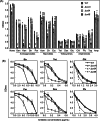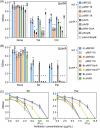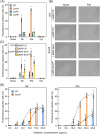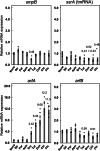Stalled ribosome rescue factors exert different roles depending on types of antibiotics in Escherichia coli
- PMID: 39843510
- PMCID: PMC11721466
- DOI: 10.1038/s44259-024-00039-2
Stalled ribosome rescue factors exert different roles depending on types of antibiotics in Escherichia coli
Abstract
Escherichia coli possesses three stalled-ribosome rescue factors, tmRNA·SmpB (primary factor), ArfA (alternative factor to tmRNA·SmpB), and ArfB. Here, we examined the susceptibility of rescue factor-deficient strains from E. coli SE15 to various ribosome-targeting antibiotics. Aminoglycosides specifically decreased the growth of the ΔssrA (tmRNA gene) strain, in which the levels of reactive oxygen species were elevated. The decrease in growth of ΔssrA could not be complemented by plasmid-borne expression of arfA, arfB, or ssrAAA to DD mutant gene possessing a proteolysis-resistant tag sequence. These results highlight the significance of tmRNA·SmpB-mediated proteolysis during growth under aminoglycoside stress. In contrast, tetracyclines or amphenicols decreased the growth of the ΔarfA strain despite the presence of tmRNA·SmpB. Quantitative RT-PCR revealed that tetracyclines and amphenicols, but not aminoglycosides, considerably induced mRNA expression of arfA. These findings indicate that tmRNA·SmpB, and ArfA exert differing functions during stalled-ribosome rescue depending on the type of ribosome-targeting antibiotic.
© 2024. The Author(s).
Conflict of interest statement
Competing interests: The authors declare no competing interests.
Figures






Similar articles
-
The ribosome rescue pathways SsrA-SmpB, ArfA, and ArfB mediate tolerance to heat and antibiotic stresses in Azotobacter vinelandii.FEMS Microbiol Lett. 2022 Nov 17;369(1):fnac104. doi: 10.1093/femsle/fnac104. FEMS Microbiol Lett. 2022. PMID: 36368695
-
Ribosome rescue by Escherichia coli ArfA (YhdL) in the absence of trans-translation system.Mol Microbiol. 2010 Nov;78(4):796-808. doi: 10.1111/j.1365-2958.2010.07375.x. Epub 2010 Sep 24. Mol Microbiol. 2010. PMID: 21062370
-
tmRNA regulates synthesis of the ArfA ribosome rescue factor.Mol Microbiol. 2011 Jun;80(5):1204-19. doi: 10.1111/j.1365-2958.2011.07638.x. Epub 2011 Mar 30. Mol Microbiol. 2011. PMID: 21435036 Free PMC article.
-
Structural Basis for Ribosome Rescue in Bacteria.Trends Biochem Sci. 2017 Aug;42(8):669-680. doi: 10.1016/j.tibs.2017.05.009. Epub 2017 Jun 16. Trends Biochem Sci. 2017. PMID: 28629612 Review.
-
The fail-safe system to rescue the stalled ribosomes in Escherichia coli.Front Microbiol. 2014 Apr 10;5:156. doi: 10.3389/fmicb.2014.00156. eCollection 2014. Front Microbiol. 2014. PMID: 24782844 Free PMC article. Review.
References
LinkOut - more resources
Full Text Sources

